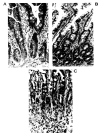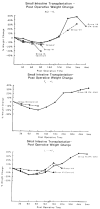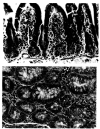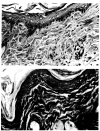The use of FK-506 for small intestine allotransplantation. Inhibition of acute rejection and prevention of fatal graft-versus-host disease
- PMID: 1690469
- PMCID: PMC2987596
- DOI: 10.1097/00007890-199003000-00001
The use of FK-506 for small intestine allotransplantation. Inhibition of acute rejection and prevention of fatal graft-versus-host disease
Abstract
Small intestine allotransplantation in humans is not yet feasible due to the failure of the current methods of immunosuppression. FK-506, a powerful new immunosuppressive agent that is synergistic with cyclosporine, allows long-term survival of recipients of cardiac, renal, and hepatic allografts. This study compares the effects of FK-506 and cyclosporine on host survival, graft rejection, and graft-versus-host-disease in a rat small intestine transplantation model. Transplants between strongly histoincompatible ACI and Lewis (LEW) strain rats, and their F1 progeny are performed so that graft rejection alone is genetically permitted (F1----LEW) or GVHD alone permitted (LEW----F1) or that both immunologic processes are allowed to occur simultaneously (ACI----LEW). Specific doses of FK-506 result in prolonged graft and host survival in all genetic combinations tested. Furthermore, graft rejection is prevented (ACI----LEW model) or inhibited (rejection only model) and lethal acute GVHD is eliminated. Even at very high doses, cyclosporine did not prevent graft rejection or lethal GVHD, nor did it allow long-term survival of the intestinal graft or the host. Animals receiving low doses of cyclosporine have outcomes similar to the untreated control groups. No toxicity specific to FK-506 is noted, but earlier studies by other investigators suggest otherwise.
Figures





References
-
- Reznick RK, Craddock GN, Langer B, et al. Structure and function of small bowel allografts in the dog: immunosuppression with cyclosporin A. Can J Surg. 1982;25:51. - PubMed
-
- Grant P, Duff J, Zhong R, et al. Successful intestinal transplantation in pigs treated with cyclosporine. Transplantation. 1988;45:279. - PubMed
-
- Lee KKW, Schraut WH. Structure and function of orthotopic small-bowel allografts in rats with cyclosporin A. Am J Surg. 1986;151:55. - PubMed
-
- Harmel RP, Stanley M. Improved survival after allogeneic small intestinal transplantation in the rat using cyclosporine immunosuppression. J Pediatr Surg. 1986;21:214. - PubMed
Publication types
MeSH terms
Substances
Grants and funding
LinkOut - more resources
Full Text Sources
Medical
